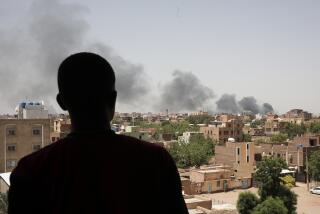More Troops and Planes Sent to Ethiopia : U.S. Increases Leland Search Force
- Share via
WASHINGTON — The United States dispatched additional troops and planes Saturday to supplement the search for missing Rep. Mickey Leland (D-Tex.) in Ethiopia, and the Soviet Union and two U.N. agencies joined the effort, according to U.S. officials.
Officials also said that the earlier search area will be extended to include parts of eastern Sudan. That reflects the U.S. government’s belief that bad weather may have forced the twin-engine plane carrying Leland and 15 others to fly over the border between Ethiopia and Sudan when it disappeared Monday night.
Sudanese rebels also were informed of the effort and were joining in the search, which again Saturday failed to find any trace of the missing aircraft.
The rebels’ battle with Sudan’s government has helped drive Sudanese refugees into Ethiopian camps, including the one in Fugnido for which Leland and his entourage were bound when the plane vanished. Leland, who chairs the House Select Committee on Hunger, was in Ethiopia to visit refugee camps.
As the expanded search for the missing plane continued, a Pentagon expert expressed guarded optimism Saturday that Leland’s party might still be alive after five days in the bush. If they survived a crash, the plane’s passengers would be “in the able care of the bush pilots, who presumably know how to survive in the bush in those eventualities,” U.S. Navy Capt. Stan Bloyer, a staff officer of the Joint Chiefs of Staff, said in a Pentagon news conference. “We’re going to continue to operate on the premise that there are survivors.”
In addition, officials said that two members of Leland’s party, both employees of the U.S. Agency for International Development, had extensive Red Cross emergency medical training.
Leland Staff ‘Gratified’
Meanwhile, Leland’s press secretary here said the lawmaker’s office is “tremendously gratified” by the growing search effort. “Our forces are the best-equipped, the best-trained, the most efficient,” said Alma Newsom, who had charged Friday that the United States was not doing enough to find the missing plane.
“When the U.S. armed services come to the rescue, they have no peer,” Newsom added.
The Pentagon, bowing to the complaints of Leland’s office, announced Saturday that three more C-130 cargo planes with medical and communications gear will leave the United States at midday today to join in the search.
A C-141 transport plane departed Saturday morning, carrying the officer who will assume command of the U.S. search and rescue effort, Air Force Maj. Gen. James F. Record. Another American C-141 left Frankfurt, West Germany, on Saturday, the Pentagon said, bringing the number of U.S. planes in Ethiopia to eight fixed-wing aircraft and four helicopters. With the addition of 100 more U.S. troops headed for Ethiopia throughout the weekend, the U.S. military presence there will rise to 265 soldiers and Air Force personnel, enabling the search planes to operate for longer periods.
At first light Saturday, two U.S. C-130 aircraft and four Blackhawk helicopters as well as three Ethiopian aircraft resumed a search of the Gambela and Dembi Dolo areas, near the Ethiopian refugee camp that was Leland’s destination, a spokeswoman for the State Department’s Leland Task Force said.
In the mountainous Goba region southeast of Addis Ababa, where a U.S. weather satellite picked up an emergency signal Thursday, U.S. U-2 spy planes continued overflights, while two Ethiopian helicopters flown by Soviet pilots searched closer to the ground, the State Department said. The Soviets have played a major role in the last decade as advisers to the Ethiopian government and military.
“Congressman Leland would be delighted” with the participation of the Soviet military advisers, said Timmi Jensen, a spokeswoman for Leland’s office. “He’s always been one to dialogue with everybody. He thinks we’re one big family.”
The Pentagon’s Bloyer noted, however, that any signal from the plane’s emergency transmitter--a critical means of locating a downed plane--would probably become too weak to pick up after a week.
“I’m not aware of any search effort anywhere in the world that has involved more U.S. military assets than have been applied to this particular search,” Bloyer said. “Keeping in mind that it’s a very long way away in somebody else’s country in very difficult conditions, I don’t know of any search and rescue (mission) that’s involved this many airplanes.”
Bloyer detailed the difficulties of searching for wreckage in the rugged terrain and under the low cloud cover that prevails throughout most of the search areas.
“It’s not the kind of place where you want to be flying airplanes in that kind of weather, especially in the highland region, just because of the risk to the search air crews,” Bloyer said.
While the United States has flown in aircraft equipped with night-vision scopes and goggles, Bloyer said that “prudence dictates that we probably not conduct routine search operations at night in the mountains, where rocks are poking up in the clouds . . . up in that very, very rugged country.”
Leland’s office said that planes from the U.N. Children’s Fund and the U.N. Food and Agriculture Organization also began assisting the search Saturday as the effort concentrated on the swampy part of western Ethiopia around the Fugnido refugee camp near the Sudanese border.
Joyce Williams, a staff member working for California Rep. Ronald V. Dellums (D-Berkeley), who is an expert in child nutrition, is one of nine Americans aboard the plane.
More to Read
Sign up for Essential California
The most important California stories and recommendations in your inbox every morning.
You may occasionally receive promotional content from the Los Angeles Times.














